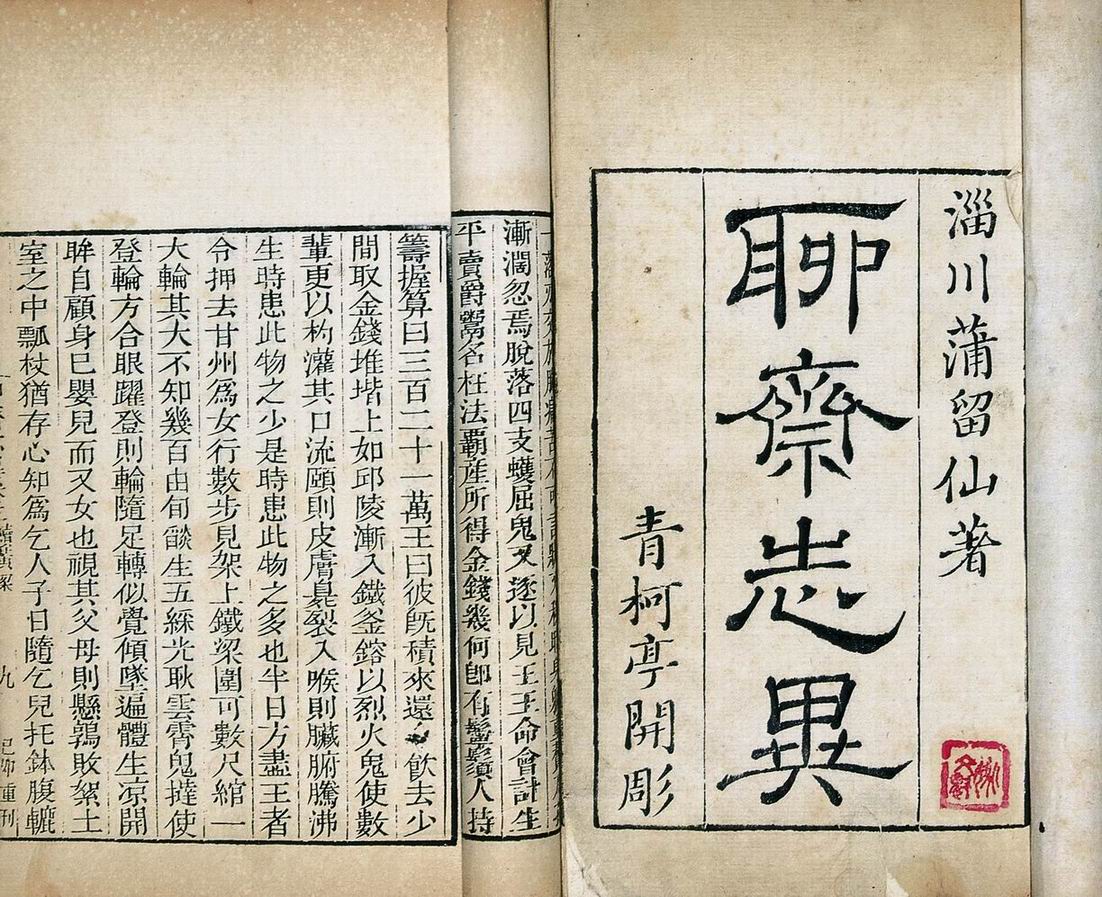Mythological images in shenguai fiction
Author : Liu Yongqiang Source : Chinese Social Sciences Today 2015-02-28

Strange Stories from a Chinese Studio or Liaozhai Zhiyi is a collection of nearly 500 mostly supernatural tales written by Pu Songling in Classical Chinese during the early Qing Dynasty (1616-1911).
Shenguai fiction (the fictions of god and demons) in ancient China has a long history and is large in quantity. Despite different genres, creation concepts and narration styles shenguai fiction underwent during its development process, it always used mythological images as its major characters. Shenguai fiction should be one major subject for research on Chinese ancient fiction.
Inherent artistic principles
Currently, studies of shenguai fiction mainly focus on three aspects: studies of the history of fictions; studies of relations between shenguai fictions and religious cultures; and studies of masterpiece of shenguai fiction like Journey to the West and Strange Stories from a Chinese Studio. Publications on styles and artistic characteristics of shenguai fictions have also be seen in recent years.
On the whole, there has been much research on this literature phenomenon and its cultural backgrounds in different times. But there are insufficient studies on its artistic technique of featuring mythological image. Only with sufficient exploration in this respect can we interpret the internal law of the development of shenguai fiction from the perspective of its inherent artistic principles rather than from external cultural backgrounds, establish its unique artistic status and evaluation criteria by distinguishing the aesthetic characteristics of it featuring mythological images rather than real images, and ultimately understand the position of Chinese ancient fiction in world literary history and its impact on modern literary creation.
Varying styles in different periods
Theoretical exploration of shenguai fiction can be carried out from two angles. The first angle is to compare shenguai fiction created in different periods and from different cultural backgrounds, centering on major issues occurring on different development stages of shenguai fiction.
For example, zhiguai (fiction of the miraculous), one school of shenguai fiction, as a literary form and style running through the whole fiction history in ancient China, displays varied characteristics in different periods which can be ascribed to diversified cultural backgrounds and religious beliefs. Therefore, to examine relations between cultural backgrounds and religious beliefs in different periods, regions and groups and creation of zhiguai fiction can greatly facilitate the discussion of development and evolution of this literary phenomenon.
Another school of shenguai fiction, legends in the Tang Dynasty (618-907), is seen as an independent literary form in ancient China. One critical feature is its sophisticated technique of depicting mythological images. According to images in these legends and their relations with mythology of prehistoric times and Buddhist and Taoist myths, legends in the Tang Dynasty can be further specified into different styles, which enables us to more accurately grasp the accomplishment of this school.
Mythological images unique artistic technique
Another angle is to inquire into the artistic principles applied in shenguai fiction drawing upon phenomena and issues appearing with regularity in creation process of shenguai fiction to discover its narrative modes and aesthetic characteristics. The source material for writing shenguai fiction is not ordinary ones, rather it is a system of images for fictionists to observe, elaborate on, and give free rein to their imagination. Therefore, we should pay close attention to those mythological images when examining the art of shenguai fiction.
After the introduction of science and civilization from the West into China, shenguai fiction was sneered at as “superstitious” and “ignorant” and declined with other ancient literary forms, while only a few of them which have been labeled as “romantic” survived.
Today, people have made significant progress in understanding ancient literature. Accordingly, theoretical interpretation of artistic traditions of shenguai fiction should also improve. We should examine shenguai fiction as a whole in history and take the adoption of mythological images as a unique artistic technique, to analyze its inner dynamics of development and its values in literary history. We should also develop more academic topic pertaining to shenguai fiction and construct a theoretical framework for studying mythological images in shenguai fiction.
The Chinese version appeared in Chinese Social Sciences Today, No. 696, January 23, 2014.
The Chinese link: http://sscp.cssn.cn/xkpd/wx_20167/201501/t20150123_1489310.html
Translated by Du Mei
Ye Shengtao made Chinese fairy tales from a wilderness
Ye Shengtao (1894–1988) created the first collection of fairy tales in the history of Chinese children’s literature...
-
How northern ethnicities integrated into Chinese nation
2023-09-18
-
Mogao caves
2023-09-12
-
Mogao Grottoes as ‘a place of pilgrimage’
2023-09-12
-
Time-honored architectural traditions in China
2023-08-29
-
Disentangling the civilizational evolution of China
2023-08-28
-
AI ethics in science fiction
2023-08-23














 2011-2013 by www.cssn.cn. All Rights Reserved
2011-2013 by www.cssn.cn. All Rights Reserved